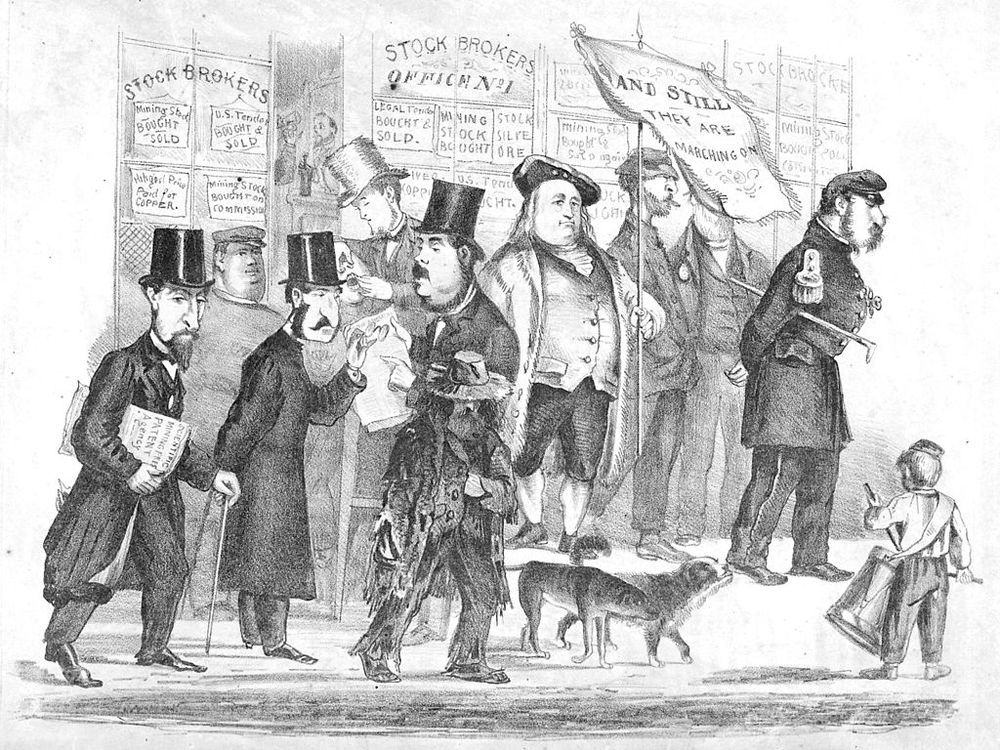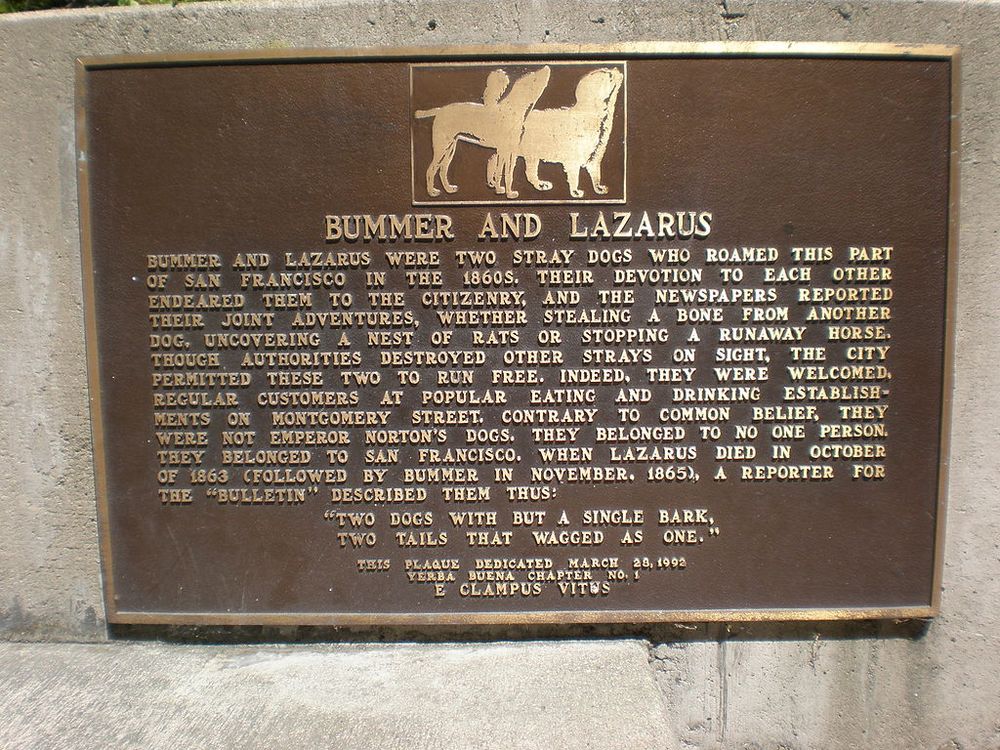The California Gold Rush brought not only people to the gold fields but dogs as well. These canines served foremost as companions to miners, and as beasts of burden, hauling sledges and carts full of ores. By the time the Gold Rush was over, thousands of these animals, now abandoned by their owners, were roaming the streets harassing horses, attacking women and children, fighting with each other, and howling and barking. In some cities, such as Los Angeles, they outnumbered humans by nearly two to one.

Bummer and Lazarus ambling along Montgomery Street. Illustration by Edward Jump.
Dogs were regularly poisoned. Municipalities often paid bounties for them, and many were killed, skinned and turned into gloves and belts. The only way a dog could save its neck is by turning into a rat catcher. Rats were as big a nuisance as dogs, and many residents paid top dollar for terriers who had proved themselves to be proficient rat killers. Dogs regularly drew a crowd when they were loosed upon their prey in city streets. They also raced with each other, or against the clock, in barroom competitions organized to see how many rats they could kill in a set period of time.
As in every other city in California, San Francisco also had a terrible dog problem. In 1860, the Daily Alta California wrote:
The city is infested with thousands of worthless mangy curs of dogs, whose numbers have at last become intolerable ... We never knew a city in America so cursed with the canine nuisance as San Francisco. Sometimes at night, their howling is enough to drive one distracted.
One day in 1860, a black and white Newfoundland mix showed up outside of Frederick Martin’s saloon, a drinking establishment renowned for its cheap liquor. It was frequented by many reporters and newspaper journalists who would later make the dog famous. The saloon-goers named him Bummer, because of his regular begging for food. Bummer was prodigiously good at killing rats, a talent that spared him the fate of the former owner of the territory, Bruno, who had been poisoned with strychnine shortly before Bummer's arrival.

Bummer and Lazarus begging scraps from Emperor Norton. Illustration by Edward Jump.
A year later, Bummer saved a smooth coat cur from a larger dog, who had come close to biting off his leg. Bystanders did not expect the injured dog to live, but Bummer nursed him back to health, feeding him scraps he collected from his scavenging missions and keeping him warm at night. With a few weeks, the dog was up and soon the duo were seen patrolling together Montgomery Street. The new dog was named Lazarus, for his remarkable recovery.
Lazarus proved to be an even more prodigious ratter than Bummer. According to one report, Bummer and Lazarus once finished off 85 rats in twenty minutes. At another rat-catching contest the duo beat out all other competition, including pedigree dogs.
Bummer and Lazarus friendship won the hearts of Californians all over, and their exploits made regular news in San Francisco. Once, Lazarus nipped into a stationary store and got locked in overnight.
“He tried to break jail but it was a no-go,” the Alta California reported. “He dashed his head against the thick plate glass, cracking it in several places, then jumped on the cases, and smashed up various delicate and valuable articles with perfect recklessness.”
On another occasion, a police officer was having trouble arresting a man accused of assault, when Bummer and Lazarus arrived to assist. They “pitched in,” tearing the man’s clothes and “barking” his legs until the man fell to the ground.
In 1862, the city appointed a new dog catcher, who, unaware of the two dog’s reputation, picked up Lazarus. When news of his impounding reached citizens, a mob marched down to the pound and demanded his release. The dog catcher sensibly released Lazarus into their custody. To protect the city’s two beloved dogs from dog catchers in future, the citizens wrote a petition asking for permanent protection for Bummer and Lazarus. Hundreds of people signed the petition and presented it to the Board of Supervisors. The Board agreed and passed an ordinance granting both dogs a free run of the town for the rest of their lives.
Despite receiving protection from the city, the life of a stray was still full of perils. In October 1863, someone deliberately fed Lazarus meat laced with poison. Angry residents put up a $50 reward for the capture of the poisoner.
The city mourned his death. The Daily Evening Bulletin featured a long obituary entitled "Lament for Lazarus" in which they praised the virtues of both dogs and recounted their various adventures together.
The Red Bluff Independent reported: “Bummer saw the body, but left it with tears in his eyes, and for hours after walked the pave of Montgomery Street. We may soon expect to chronicle the death of the faithful and inconsolable friend.”
Someone suggested that Lazarus be buried in a place of honor alongside other great men of the city. Lazarus wasn’t buried though; he was stuffed by a taxidermist and displayed behind the bar in Martin's saloon.

An imaginary funeral of Lazarus. Illustration by Edward Jump.
Without his faithful companion, Bummer became morose but he slogged on for a few more years. At one point, he appeared to take a new friend under his wing, but he never bonded with the dog the way he had bonded with Lazarus. Like his old friend, Bummer too died a cruel death, when a drunkard kicked him down a stairway in November 1865. The city immediately arrested the drunkard and threw him in the jail. When his cellmate learned of his crime, he apparently “popped him in the smeller.”
Mark Twain, then a young reporter for the Virginia City (Nevada) Territorial Enterprise, wrote a characteristically sarcastic obituary in which he said that Bummer “should have died sooner: there was a time when his death would have left a lasting legacy of fame to his name. Now, however, he will be forgotten in a few days.” The Bulletin referred to them as “two dogs with but a single bark, two tails that wagged as one.”
After his death, Bummer too was taxidermied and placed on display at Martin’s Saloon, along with Lazarus, where they remained for four decades. In 1906, both specimens were donated to the Golden Gate Park museum where they remained in storage until they were destroyed in 1910.
In 1992, a plaque was mounted at Transamerica Redwood Park on Montgomery Street, honoring the two dogs. It declares: “They belonged to no one person. They belonged to San Francisco.”

The death of Bummer. Illustration by Edward Jump.

A plaque commemorating the dogs Bummer and Lazarus in Transamerica Redwood Park in San Francisco. Photo: BrokenSphere/Wikimedia
References:
# Katie Dowd, “San Francisco's first celebrity family was a pair of stray dogs named Bummer and Lazarus”, SF Gate
# Rae Alexandra, “Bummer and Lazarus: An Epic Gold Rush Tale of Triumph and Tragedy”, KQED
# “Bummer and Lazarus”, Found SF



Comments
Post a Comment